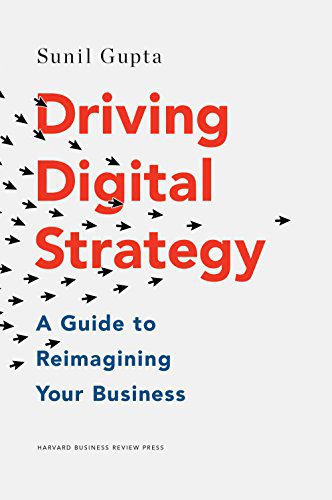Print | Kindle (eBook) | Audiobook
Sunil Gupta is the Edward W. Carter Professor of Business Administration and co-chair of the executive program on Driving Digital Strategy at Harvard Business School. The Driving Digital Strategy book is a comprehensive guide on how organizations can take full advantage of the limitless opportunities the digital age provides.
The book shows through a broad range of examples, how organizations are going about their digital transformation. Sunil compiles case studies and best practices from companies that have reinvented their businesses and provides a framework that can help in the process of an all-encompassing digital strategy while leading your entire organization through the transformation process.
Here are my favourite take-aways from reading, Driving Digital Strategy: A Guide to Reimagining Your Business by Sunil Gupta:
Where Companies Go Wrong
To mitigate the effects of digital disruption while also exploring new opportunities, companies have typically followed some combination of these three strategies–creating small, independent units or startups within the larger organization; doing a series of digital experiments; and/or leveraging technology to cut costs and improve efficiency. However, in most cases, these initiatives have led to limited success.
Independent Digital Units
Almost every large company launches independent digital units or has outposts in Silicon Valley, with the hope that a handful of young entrepreneurs will spark innovation for the firm.
Creating an independent unit is like launching a speedboat to turn around a large ship. Often the speedboat takes off but does little to move the ship.
Experiment Approach
Companies tend to run experiments, which makes a lot of sense given the rapidly changing environment and uncertainty about the future. This journey often begins with a few tactical experiments, typically in marketing departments, where employees are quick to try new social media tools or new mobile platforms. As the excitement around digital spreads throughout the organization, new initiatives start emerging all over the company, leading to a proliferation.
Leveraging Technology
A third approach is to leverage technology to reduce costs and improve the efficiency of operations. For instance, banks close branches as consumers move to online and mobile banking. Retail stores reduce their real estate footprint and close marginal stores. Processes are digitized and streamlined to minimize overlap and increase efficiency. Many of the internal tasks are redesigned to allow customers to self-serve, thereby reducing labor costs.
“Companies should always try to improve efficiency and minimize cost. However, if you rely solely on this approach, you are implicitly assuming that technology will not fundamentally change your business. Effectively you are assuming that banks, for instance, will still operate as before and that fintech companies won’t have a major impact on their business. In many cases this may be a flawed assumption.”
Digital Strategy
In order to be successful, you can’t just create a separate digital unit, or run experiments, or use technology to improve efficiency. Instead, you must make digital strategy an integral part of your overall business strategy. That is, rather than treating digital strategy as a separate exercise, you must embed it into the operations and DNA of your organization, in a way that touches all aspects of your business.
Crafting a Strategic View: A Framework for Reinventing Business
The framework consists of four key components:
- Reimagining your business
- Reevaluating your value chain
- Reconnecting with customers
- Rebuilding your organization
Reimagine Your Business
Given the dramatic changes that digital has caused, you’ll need to sit back and reflect on the core essence of your business, examining three components: scope, business model, and ecosystem.
“When considering scope, you’ll need to ask yourself this fundamental question: “What business are we in?”
Competition in the digital age usually comes laterally, from new players, and redefining the scope of your business is essential to ensuring future success. This requires a careful balance of broadening the scope of your business while staying within your core competencies.
Reevaluate Your Value Chain
Digital technology can significantly improve the efficiency and effectiveness of various parts of your value chain, especially as new models of R&D and innovation have emerged. Companies such as GE, P&G, and Siemens have leveraged open innovation to redefine their R&D process.
Digital technology has also ushered in a new era of Industry 4.0. Innovations such as digital manufacturing, virtual and augmented reality, 3-D printing, and digital supply chains are improving operational excellence.
Reconnect with Your Customers
“Digital technology has changed the way consumers search for information and buy products, and technology is enabling firms to collect information about the entire consumer decision journey or path to purchase, which will open up new ways for you to acquire customers.
Long before a consumer buys a car, she searches for information on Google, which provides an opportunity for auto manufacturers to understand her preferences and influence her behavior. Sensors in washing machines will soon allow Whirlpool to understand consumers’ usage behavior and even provide valuable consumption data about laundry detergent to P&G. And as consumers increasingly rely on online reviews and friends’ advice, you can monitor social media to understand how those friends and reviewers might be converted into brand advocates.
Rebuild Your Organization
Managing the digital transition in a large organization is a nontrivial task. As you try to strengthen your core business and build for the future at the same time, you’ll face the challenge of running two organizations in parallel. As a result, revenues and profits often decline during the transition period before they go back up, which can shake the resolve of even the most confident CEO.
Amazon competes with Barnes & Noble, Best Buy, and Walmart.
As an online platform
Amazon competes with eBay. In cloud computing, it battles for market share with IBM, Google, and Microsoft.
In streaming services, it has Netflix and Hulu as formidable competitors. Amazon Studios puts the company up against Disney and NBC Universal Studios.
Its entry into mobile phones put it in the crosshairs of Apple, HTC, and Samsung. Its ad network made it Google’s rival.
Competition Is No Longer Defined by Traditional Industry Boundaries
It should be clear from the discussion so far that competition is no longer defined by traditional product or industry boundaries. The rapid development of technology is making data and software integral to almost all businesses, which is blurring industry boundaries faster than ever before.
Amazon surprised Google by becoming the dominant competitor in the search market.
Apple is hiring automobile engineers at a rate that is scaring the auto industry. Netflix and, more recently, streaming services by HBO and CBS are causing concern for Comcast and other cable players.
Platforms
A platform offers scale with low capital investment, but it comes with limited control that may lead to poor customer experience. Companies that rely heavily on their platform spend enormous amounts of time and effort managing customer experience.
As devices become embedded with sensors, their value is less in the hardware itself and more in the interconnectedness of that hardware. In the connected world, the battle is no longer fought among products. Instead, competitive advantage comes from building a platform that has an ecosystem around it. However, the journey from product to platform is not always easy or quick, and often a company’s business model evolves over time to reach this stage.
In order to collaborate and partner with many players, some of whom may even be their competitors. And this requires new skills and capabilities to manage and govern a platform.
The 200-20 Rule
According to the familiar 80-20 rule, 20 percent of the customers provide 80 percent of the revenue. However, research shows that if we focus on profitability instead of revenues, the rule would be 200-20, where 20 percent of the customers provide almost 200 percent of the profit!
In other words, a company’s profits would soar if it were to jettison the bottom 80 percent of its customers. Of course, some of these unprofitable customers may be important for other, strategic reasons, but this analysis forces management to articulate the reasons for retaining these unprofitable customers.
Often there is a tendency to get seduced by the latest technology or the new business model of a hot startup. While incumbents should always learn from others, they should stay true to their core DNA and leverage the assets they have.
Digital Transition
Digital transition involves managing existing business and building for the future at the same time. It is like changing the engine of a plane while in flight. The plane is going to go down first before it goes up again–and that is a scary and uncertain time, when everyone in the organization starts questioning the company’s strategy. Even though existing businesses may be under threat and in need of change, they are usually still profitable in the short run, and it is hard to give up all those profits for an uncertain future.
According to an IBM report, we create 2.5 quintillion bytes of data every day.
Data Analytics, Machine Learning, and Artificial Intelligence
According to an IBM report, we create 2.5 quintillion bytes of data every day. Put differently, 90 percent of the data in the world today has been created in the last two years. This data comes from consumer activities such as web browsing, social media posts, and mobile usage–and increasingly from sensors built into machines. Making sense of this vast amount of data has therefore become the key challenge.
Machines will not replace human judgment, but they will be major complementary assets to what we currently do to manage talent. The technology revolution is only going to accelerate in the future, and we better prepare and brace ourselves for it.
All the Best in your quest to get Better. Don’t Settle: Live with Passion.



1 Comment
Pingback: 100 Books Reading Challenge 2021 – Lanre Dahunsi